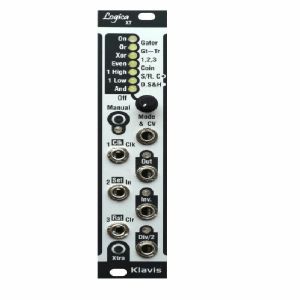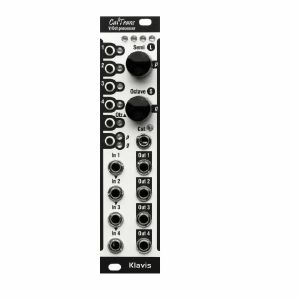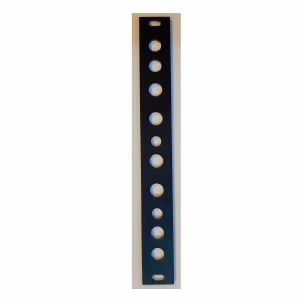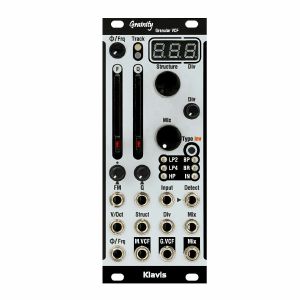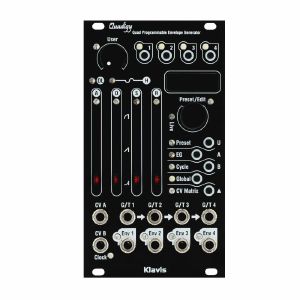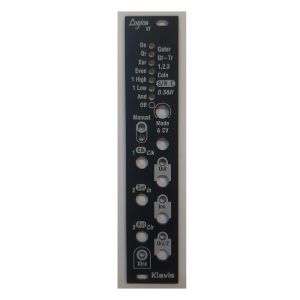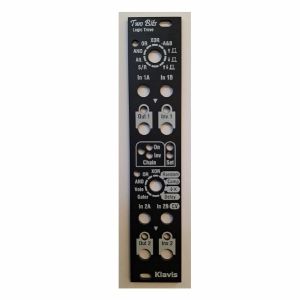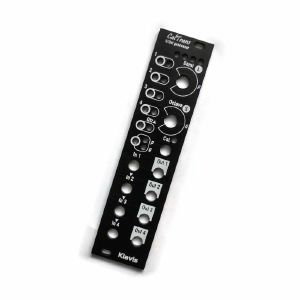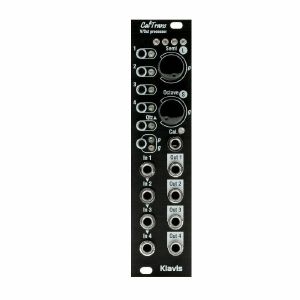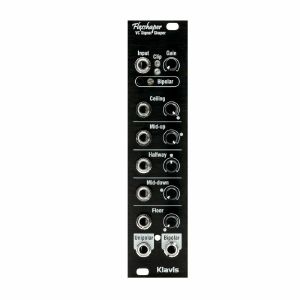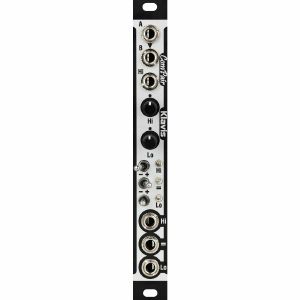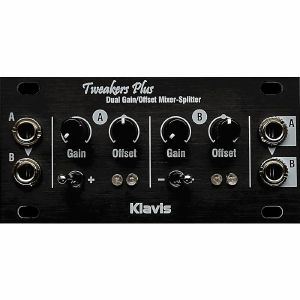Search results: klavis
Items 1 to 18 of 18 on page 1 of 1
Klavis Logica XT Voltage Controlled Logic & Gate Processor Module (silver) (delay/digital/frequency divider/logic/sample & hold/utility synth module)
Cat: 767372 Rel: 16 Apr 20 • View all Synth modules
processor module
Notes: Neat little logic and gate processor offering various modes and simple, effective processing power in a small format. Updated version adds state-based logic functions and more.
Supplier's notes:
Voltage-controlled logic and gate processor.
Built upon the foundations of its acclaimed predecessor, this new version drastically expands the feature set within the same footprint.
All the original goodies are still there, now enriched by a full list of state-based logic functions including a delay line.
Faster processing allows perfect handling of audio signals.
User editable settings are stored in non-volatile memory.
With its versatility and features never seen before, the Klavis Logica XT will arouse your creativity and bring inventiveness to your soundscapes.
… Read moreSupplier's notes:
Voltage-controlled logic and gate processor.
Built upon the foundations of its acclaimed predecessor, this new version drastically expands the feature set within the same footprint.
All the original goodies are still there, now enriched by a full list of state-based logic functions including a delay line.
Faster processing allows perfect handling of audio signals.
User editable settings are stored in non-volatile memory.
With its versatility and features never seen before, the Klavis Logica XT will arouse your creativity and bring inventiveness to your soundscapes.
1 in stock $120.99
Klavis CalTrans Programmable Volt/Octave CV Calibrator & Transposer Module (silver) (quantizer/tuner/utility/quad/slew limiter synth module)
Cat: 767379 Rel: 16 Apr 20 • View all Synth modules
calibrator & transposer module
Notes: Clever four-channel utility module designed to make it easier to achieve perfect oscillator tracking and transpose CV signals. Also includes some neat quantising and portamento features.
Supplier notes:
The CalTrans solves issues encountered when playing tonal music with a modular system: tracking problems, curves unrelated to Volt per octave ratio, limited octave range, cumbersome transpose, ...
The CalTrans corrects and expands the range of troublesome VCOs and brings V/Oct tracking to anything that oscillates.
Besides calibration, the CalTrans offers live play features. Each channel can be quantized and any combination of them transposed jointly.
A pair of rotary encoders with detent allow an precise selection of octaves and semitones.
VCOs whose tracking doesn't go high enough to follow the leader will see their pitch repositioned in their highest possible octave so that the global harmony is unaffected.
You can add a pinch of portamento and glissando to each channel and save the whole in user presets.
… Read moreSupplier notes:
The CalTrans solves issues encountered when playing tonal music with a modular system: tracking problems, curves unrelated to Volt per octave ratio, limited octave range, cumbersome transpose, ...
The CalTrans corrects and expands the range of troublesome VCOs and brings V/Oct tracking to anything that oscillates.
Besides calibration, the CalTrans offers live play features. Each channel can be quantized and any combination of them transposed jointly.
A pair of rotary encoders with detent allow an precise selection of octaves and semitones.
VCOs whose tracking doesn't go high enough to follow the leader will see their pitch repositioned in their highest possible octave so that the global harmony is unaffected.
You can add a pinch of portamento and glissando to each channel and save the whole in user presets.
2 in stock $165.82
Klavis Twin Waves MK2 Voltage-Controlled Dual VCO/LFO/Random Module (silver) (digital/LFO/oscillator/dual/stereo/noise/quantizer/ring modulator/random synth module)
Cat: 798332 Rel: 10 Dec 20 • View all Synth modules
Synth module
Notes: Voltage-controlled Dual VCO/LFO - two oscillators independently set as VCO or LFO.
Features in VCO mode:
V/Oct tracking over 10 octaves
Through zero and linear FM
Sub-octave output
Hard & soft synchronization
VCA control and CV algorithms selection
Quantizer with various scales
20 algorithm-based synthesis types among:
Wave shaping
Phase modulation
Phase positioning of multiple waves
Up to 5 stacked oscillators in tunable unison
Self-sync with phantom oscillator
Additive synthesis (7 waves)
Variable bit reduction (bit-crushing)
Ring modulator with its own 2nd oscillator
Noise with LPF, BPF, or resonant filter
Features in LFO mode:
Simultaneous signal and trigger outputs
External wave synchronization
Clock controlled rate with voltage controlled multiplier and divider
CV and knob control of output level
Algorithm based wave engine with a selection of:
Wave shaping
Phase modulation
Random levels and vectors (also Brownian)
Randomly spaced triggers and waves
Display with contextual icons and instant reminder help text
LEDs indicating potentiometer vs. value matching, switch settings and output levels
Automatically saved settings for instant recall at power on
Firmware update by playing an audio file via the front panel
Compact and skiff-friendly module
The driving idea behind the Twin waves voltage-controlled dual oscillator/LFO is to offer two interesting oscillators in a skiff-friendly and compact size. To achieve that challenge, Klavis built the product's architecture on the concept of pre-defined algorithms, where the most useful configurations and their matching parameter are ready to use.
This MKII evolution brings a redesigned layout, additional knobs for more hands-on fun and semi-modular cross-patching between sections.
All of the original features are present: a top selection of synthesis techniques, each with their key parameter directly at hand, enriched by a full set of complementary features.
More than ever, the Twin Waves is versatility at its best.
Dimensions:
(mm) Height: 128.40, Width: 40.40, Depth: 21.00
(Inches): Height: 5.06, Width: 1.59, Depth: 0.83
Eurorack: Height: 3HE, Width: 8HP
Depth behind panel (no supply cable inserted)- 21.00mm, 0.83 inches
Current draw
+12V: 46mA
-12V: 18mA
+5V: 0mA
… Read moreFeatures in VCO mode:
V/Oct tracking over 10 octaves
Through zero and linear FM
Sub-octave output
Hard & soft synchronization
VCA control and CV algorithms selection
Quantizer with various scales
20 algorithm-based synthesis types among:
Wave shaping
Phase modulation
Phase positioning of multiple waves
Up to 5 stacked oscillators in tunable unison
Self-sync with phantom oscillator
Additive synthesis (7 waves)
Variable bit reduction (bit-crushing)
Ring modulator with its own 2nd oscillator
Noise with LPF, BPF, or resonant filter
Features in LFO mode:
Simultaneous signal and trigger outputs
External wave synchronization
Clock controlled rate with voltage controlled multiplier and divider
CV and knob control of output level
Algorithm based wave engine with a selection of:
Wave shaping
Phase modulation
Random levels and vectors (also Brownian)
Randomly spaced triggers and waves
Display with contextual icons and instant reminder help text
LEDs indicating potentiometer vs. value matching, switch settings and output levels
Automatically saved settings for instant recall at power on
Firmware update by playing an audio file via the front panel
Compact and skiff-friendly module
The driving idea behind the Twin waves voltage-controlled dual oscillator/LFO is to offer two interesting oscillators in a skiff-friendly and compact size. To achieve that challenge, Klavis built the product's architecture on the concept of pre-defined algorithms, where the most useful configurations and their matching parameter are ready to use.
This MKII evolution brings a redesigned layout, additional knobs for more hands-on fun and semi-modular cross-patching between sections.
All of the original features are present: a top selection of synthesis techniques, each with their key parameter directly at hand, enriched by a full set of complementary features.
More than ever, the Twin Waves is versatility at its best.
Dimensions:
(mm) Height: 128.40, Width: 40.40, Depth: 21.00
(Inches): Height: 5.06, Width: 1.59, Depth: 0.83
Eurorack: Height: 3HE, Width: 8HP
Depth behind panel (no supply cable inserted)- 21.00mm, 0.83 inches
Current draw
+12V: 46mA
-12V: 18mA
+5V: 0mA
1 in stock $236.40
Klavis 2x4 Passive Multiple Module (black) (multiple synth module)
Cat: 920077 Rel: 13 Jan 23 • View all Synth modules
A passive multiple that fits nicely with the Klavis range.
Notes: A passive multiple that fits nicely with the Klavis range.
… Read more 1 in stock $36.14
Klavis Tweakers Black Replacement Panel (synth module panel)
Cat: 951677 Rel: 08 Sep 23 • View all Synth Module Accessories
2mm thick aluminium panel, in bath-anodized finish, with high-quality light-grey printing.
Notes: 2mm thick aluminium panel, in bath-anodized finish, with high-quality light-grey printing.
… Read more 1 in stock $22.40
Klavis Grainity Digitally-Controlled Full-Analogue Path Granular & Multi-Mode VCF Module (silver) (filter/phase shifter/pitch shifter module)
Cat: 934965 Rel: 19 Dec 23 • View all Synth modules
Digitally-controlled full-analogue path granular & multi-mode VCF module in 10HP.
Notes: A unique analogue take on granular synthesis, inspired by Yannis Xenakis, the Grainity pairs a granular filter with a multimode filter to create new textures and harmonics.
Supplier's Notes:
The Grainity brings a unique and never-heard-before concept to the world of analogue VCF.
While being based on analogue filtering only, the Grainity expands and enriches the sound in creating subharmonics, harmonies, unison, flanging effects and formant filtering all at once.
The module presents two sections, the granular filter itself and a typical multimode filter, each with its own output.
A third output offers a mix of both filter paths. Numerous controls and CV allow a very wide palette of results.
What is the Grainity
Granular?
The word granular was chosen for this filter module in relation to the concept invented by the composer Yannis Xenakis, and which is described as assembling small chops of sounds - he called grains - according to a pattern.
This is exactly what the Grainity does, no more no less ... but, digital control allows doing it in ways that are decades away from what tape and scissors allowed at the time.
Technology wise ...
In the granular section, the incoming sound cycle is determined in order to step through various filtering and phase variations of itself according to predefined patterns called structures.
The controls allow alterations to the cycling phase, cycling frequency offset (tuning), structure selection and frequency division of the filters cycling. This comes in addition to the usual filter frequency and resonance controls.
What the Grainity is not
Technology wise ...
Despite relying on a microprocessor, the Grainity is not a digital audio processor. At any time, the sound remains in the analog domain and goes through analog circuits from in to out.
The digital processor does not convert or generate audio signals; it is there to control the analog circuitry and manage the interface and display.
Sound wise ...
Several digital modules offering granular processing rely on the layering of sound grains, which leads to blurry and cloudy textures.
Layering of the grains is a late addition to the concept of granular synthesis and is not a mandatory feature of the concept.
The Grainity does not use delay lines or sampling memory but is nevertheless true to the foundations of the granular synthesis concept.
The granular VCF in the Grainity is unconventional in that, most of times, it is not filtering the sound in the common expectation of removing something. Typically, the granular process adds more than it removes by expanding both the lower range, creating subharmonics, and the upper harmonic contents in multiples ways.
Dimensions
10 HP
21 mm deep
Current Draw
101 mA +12V
59 mA -12V
… Read moreSupplier's Notes:
The Grainity brings a unique and never-heard-before concept to the world of analogue VCF.
While being based on analogue filtering only, the Grainity expands and enriches the sound in creating subharmonics, harmonies, unison, flanging effects and formant filtering all at once.
The module presents two sections, the granular filter itself and a typical multimode filter, each with its own output.
A third output offers a mix of both filter paths. Numerous controls and CV allow a very wide palette of results.
What is the Grainity
Granular?
The word granular was chosen for this filter module in relation to the concept invented by the composer Yannis Xenakis, and which is described as assembling small chops of sounds - he called grains - according to a pattern.
This is exactly what the Grainity does, no more no less ... but, digital control allows doing it in ways that are decades away from what tape and scissors allowed at the time.
Technology wise ...
In the granular section, the incoming sound cycle is determined in order to step through various filtering and phase variations of itself according to predefined patterns called structures.
The controls allow alterations to the cycling phase, cycling frequency offset (tuning), structure selection and frequency division of the filters cycling. This comes in addition to the usual filter frequency and resonance controls.
What the Grainity is not
Technology wise ...
Despite relying on a microprocessor, the Grainity is not a digital audio processor. At any time, the sound remains in the analog domain and goes through analog circuits from in to out.
The digital processor does not convert or generate audio signals; it is there to control the analog circuitry and manage the interface and display.
Sound wise ...
Several digital modules offering granular processing rely on the layering of sound grains, which leads to blurry and cloudy textures.
Layering of the grains is a late addition to the concept of granular synthesis and is not a mandatory feature of the concept.
The Grainity does not use delay lines or sampling memory but is nevertheless true to the foundations of the granular synthesis concept.
The granular VCF in the Grainity is unconventional in that, most of times, it is not filtering the sound in the common expectation of removing something. Typically, the granular process adds more than it removes by expanding both the lower range, creating subharmonics, and the upper harmonic contents in multiples ways.
Dimensions
10 HP
21 mm deep
Current Draw
101 mA +12V
59 mA -12V
2 in stock $266.65
Klavis Grainity Digitally-Controlled Full-Analogue Path Granular & Multi-Mode VCF Module (black) (filter/phase shifter/pitch shifter module)
Cat: 951606 Rel: 15 Jan 24 • View all Synth modules
Digitally-controlled full-analogue path granular and multi-mode VCF module - 10HP.
Notes: Digitally-controlled full-analogue path Granular + Multimode VCF
The Grainity brings a unique and never-heard-before concept to the world of analogue VCF.
While being based on analogue filtering only, the Grainity expands and enriches the sound in creating subharmonics, harmonies, unison, flanging effects and formant filtering all at once.
The module presents two sections, the granular filter itself and a typical multimode filter, each with its own output.
A third output offers a mix of both filter paths. Numerous controls and CV allow a very wide palette of results.
What is the Grainity
Granular?
The word granular was chosen for this filter module in relation to the concept invented by the composer Yannis Xenakis, and which is described as assembling small chops of sounds - he called grains - according to a pattern.
This is exactly what the Grainity does, no more no less ... but, digital control allows doing it in ways that are decades away from what tape and scissors allowed at the time.
Technology wise ...
In the granular section, the incoming sound cycle is determined in order to step through various filtering and phase variations of itself according to predefined patterns called structures.
The controls allow alterations to the cycling phase, cycling frequency offset (tuning), structure selection and frequency division of the filters cycling. This comes in addition to the usual filter frequency and resonance controls.
What the Grainity is not
Technology wise ...
Despite relying on a microprocessor, the Grainity is not a digital audio processor. At any time, the sound remains in the analogue domain and goes through analogue circuits from in to out.
The digital processor does not convert or generate audio signals; it is there to control the analogue circuitry and manage the interface and display.
Sound wise ...
Several digital modules offering granular processing rely on the layering of sound grains, which leads to blurry and cloudy textures.
Layering of the grains is a late addition to the concept of granular synthesis and is not a mandatory feature of the concept.
The Grainity does not use delay lines or sampling memory but is nevertheless true to the foundations of the granular synthesis concept.
The granular VCF in the Grainity is unconventional in that, most of times, it is not filtering the sound in the common expectation of removing something. Typically, the granular process adds more than it removes by expanding both the lower range, creating subharmonics, and the upper harmonic contents in multiples ways.
Dimensions
10 HP
21 mm deep
Current Draw
101 mA +12V
59 mA -12V
0 mA 5V
… Read moreThe Grainity brings a unique and never-heard-before concept to the world of analogue VCF.
While being based on analogue filtering only, the Grainity expands and enriches the sound in creating subharmonics, harmonies, unison, flanging effects and formant filtering all at once.
The module presents two sections, the granular filter itself and a typical multimode filter, each with its own output.
A third output offers a mix of both filter paths. Numerous controls and CV allow a very wide palette of results.
What is the Grainity
Granular?
The word granular was chosen for this filter module in relation to the concept invented by the composer Yannis Xenakis, and which is described as assembling small chops of sounds - he called grains - according to a pattern.
This is exactly what the Grainity does, no more no less ... but, digital control allows doing it in ways that are decades away from what tape and scissors allowed at the time.
Technology wise ...
In the granular section, the incoming sound cycle is determined in order to step through various filtering and phase variations of itself according to predefined patterns called structures.
The controls allow alterations to the cycling phase, cycling frequency offset (tuning), structure selection and frequency division of the filters cycling. This comes in addition to the usual filter frequency and resonance controls.
What the Grainity is not
Technology wise ...
Despite relying on a microprocessor, the Grainity is not a digital audio processor. At any time, the sound remains in the analogue domain and goes through analogue circuits from in to out.
The digital processor does not convert or generate audio signals; it is there to control the analogue circuitry and manage the interface and display.
Sound wise ...
Several digital modules offering granular processing rely on the layering of sound grains, which leads to blurry and cloudy textures.
Layering of the grains is a late addition to the concept of granular synthesis and is not a mandatory feature of the concept.
The Grainity does not use delay lines or sampling memory but is nevertheless true to the foundations of the granular synthesis concept.
The granular VCF in the Grainity is unconventional in that, most of times, it is not filtering the sound in the common expectation of removing something. Typically, the granular process adds more than it removes by expanding both the lower range, creating subharmonics, and the upper harmonic contents in multiples ways.
Dimensions
10 HP
21 mm deep
Current Draw
101 mA +12V
59 mA -12V
0 mA 5V
1 in stock $266.65
Klavis Quadigy Quad Programmable Envelope Generator Module (black) (envelope generator/LFO/quad module)
Cat: 951653 Rel: 15 Jan 24 • View all Synth modules
Quad programmable envelope generator module - 14HP.
Notes: The Quadigy is a complex envelope generator focused on live play.
The goal is to allow the user setting up rich, interactive and dynamically evolving envelopes without the risk of breaking up a subtle and intricate patch once on stage.
This is achieved by offering two main modes, one where full control is available and a Live mode where only the settings that are sensible using on stage are accessible.
The user interface offers an intuitive access for otherwise complex settings.
Advanced features such as automatic time-stretching, multiphase clocking and full morphing put the Quadigy in a category on its own.
Dimensions
14 HP
21 mm deep
Current Draw
24 mA +12V
10 mA -12V
40 mA 5V
… Read moreThe goal is to allow the user setting up rich, interactive and dynamically evolving envelopes without the risk of breaking up a subtle and intricate patch once on stage.
This is achieved by offering two main modes, one where full control is available and a Live mode where only the settings that are sensible using on stage are accessible.
The user interface offers an intuitive access for otherwise complex settings.
Advanced features such as automatic time-stretching, multiphase clocking and full morphing put the Quadigy in a category on its own.
Dimensions
14 HP
21 mm deep
Current Draw
24 mA +12V
10 mA -12V
40 mA 5V
1 in stock $276.74
Klavis Logica XT Black Replacement Panel (synth module panel)
Cat: 951666 Rel: 06 Feb 24 • View all Synth Module Accessories
2mm thick aluminium panel, in bath-anodized finish, with high-quality light-grey printing.
Notes: 2mm thick aluminium panel, in bath-anodized finish, with high-quality light-grey printing.
… Read more 1 in stock $22.13
Klavis Mixwitch Black Replacement Panel (synth module panel)
Cat: 951669 Rel: 06 Feb 24 • View all Synth Module Accessories
2mm thick aluminium panel, in bath-anodized finish, with high-quality light-grey printing.
Notes: 2mm thick aluminium panel, in bath-anodized finish, with high-quality light-grey printing.
… Read more 1 in stock $22.40
Klavis Two Bits Black Replacement Panel (synth module panel)
Cat: 951683 Rel: 01 Mar 24 • View all Synth Module Accessories
2mm thick aluminium panel, in bath-anodized finish, with high-quality light-grey printing.
Notes: 2mm thick aluminium panel, in bath-anodized finish, with high-quality light-grey printing.
… Read more 1 in stock $22.13
Klavis Mixwitch Mixer & CV/Clock-Controlled Switcher Module (black) (attenuator/mixer/polarizer/switch synth module)
Cat: 951655 Rel: 20 Jun 24 • View all Synth modules
Mixer and CV/clock-controlled switcher module - 8HP.
Notes: Mixer & CV/clock-controlled Switcher
Focused versatility seems an oxymoron when describing the features that led to the design of the Mixwitch.
With only a pinch of mixing, inverting and controlled switching, Klavis Electronics brew up a plethora of combinations and uses.
This is voltage processing magic!
The Mixwitch design comes from a frustration with attenuvertors (bipolar attenuators-inverters) whose off (neutral) position is difficult to retrieve, especially in live situations.
Klavis went for a digitally-controlled analogue path where polarity inversion would be at the touch of a button. So, the usefulness of attenuating/inverting can be realized by turning the pot down, swiftly pressing the inversion button and reopening the level. The zero level is where you expect it, with the pot full down.
Once a clean polarity control was established, a mute function was added, offering the benefit of pre-adjusted pot settings ready to be activated at will.
The next step was to bring something extra, useful and creative. There are plenty of analogue switches controlled by a clock; but arbitrarily selecting an input with a voltage is less known. Having both control capabilities combined with Klavis' specific mixer features creates a unique fusion: welcome to the Mixwitch!
Dimensions
8 HP
25 mm deep
Current Draw
39 mA +12V
24 mA -12V
0 mA 5V
… Read moreFocused versatility seems an oxymoron when describing the features that led to the design of the Mixwitch.
With only a pinch of mixing, inverting and controlled switching, Klavis Electronics brew up a plethora of combinations and uses.
This is voltage processing magic!
The Mixwitch design comes from a frustration with attenuvertors (bipolar attenuators-inverters) whose off (neutral) position is difficult to retrieve, especially in live situations.
Klavis went for a digitally-controlled analogue path where polarity inversion would be at the touch of a button. So, the usefulness of attenuating/inverting can be realized by turning the pot down, swiftly pressing the inversion button and reopening the level. The zero level is where you expect it, with the pot full down.
Once a clean polarity control was established, a mute function was added, offering the benefit of pre-adjusted pot settings ready to be activated at will.
The next step was to bring something extra, useful and creative. There are plenty of analogue switches controlled by a clock; but arbitrarily selecting an input with a voltage is less known. Having both control capabilities combined with Klavis' specific mixer features creates a unique fusion: welcome to the Mixwitch!
Dimensions
8 HP
25 mm deep
Current Draw
39 mA +12V
24 mA -12V
0 mA 5V
1 in stock $150.13
Click for better price!
or call +44 20 7424 1960
quote 951655
quote 951655
Klavis CalTrans Black Replacement Panel (synth module panel)
Cat: 951659 Rel: 20 Jun 24 • View all Synth Module Accessories
2mm thick aluminium panel, in bath-anodized finish, with high-quality light-grey printing.
Notes: 2mm thick aluminium panel, in bath-anodized finish, with high-quality light-grey printing.
… Read more 2 in stock $22.13
Klavis CalTrans Programmable Voltage/Octave CV Calibrator & Transposer Module (black) (quantizer/tuner/utility/quad/slew limiter synth module)
Cat: 951637 Rel: 20 Jun 24 • View all Synth modules
Programmable voltage and octave CV calibrator and transposer module - 6HP.
Notes: Programmable Volt/Octave CV calibrator and transposer
Clever four-channel utility module designed to make it easier to achieve perfect oscillator tracking and transpose CV signals. Also includes some neat quantising and portamento features.
The CalTrans solves issues encountered when playing tonal music with a modular system: tracking problems, curves unrelated to Volt per octave ratio, limited octave range, cumbersome transpose, ...
The CalTrans corrects and expands the range of troublesome VCOs and brings V/Oct tracking to anything that oscillates.
Besides calibration, the CalTrans offers live play features. Each channel can be quantized and any combination of them transposed jointly.
A pair of rotary encoders with detent allow an precise selection of octaves and semitones.
VCOs whose tracking doesn't go high enough to follow the leader will see their pitch repositioned in their highest possible octave so that the global harmony is unaffected.
You can add a pinch of portamento and glissando to each channel and save the whole in user presets.
Firmware 1.17 offers:
* User editable input scaling to match sources that don't generate perfect 1V per octave signals.
* Complete rewrite of the main processing with higher precision.
* ... and the unavoidable fixes and tweaks ;-)
The updated user manual 1.4 is much expanded with operations described in exquisite details :-)
.. and a version 1.5 corrects a mistake in the input calibration description and eases the reading elsewhere.
Dimensions
6 HP
36 mm deep
Current Draw
44 mA +12V
8 mA -12V
0 mA 5V
… Read moreClever four-channel utility module designed to make it easier to achieve perfect oscillator tracking and transpose CV signals. Also includes some neat quantising and portamento features.
The CalTrans solves issues encountered when playing tonal music with a modular system: tracking problems, curves unrelated to Volt per octave ratio, limited octave range, cumbersome transpose, ...
The CalTrans corrects and expands the range of troublesome VCOs and brings V/Oct tracking to anything that oscillates.
Besides calibration, the CalTrans offers live play features. Each channel can be quantized and any combination of them transposed jointly.
A pair of rotary encoders with detent allow an precise selection of octaves and semitones.
VCOs whose tracking doesn't go high enough to follow the leader will see their pitch repositioned in their highest possible octave so that the global harmony is unaffected.
You can add a pinch of portamento and glissando to each channel and save the whole in user presets.
Firmware 1.17 offers:
* User editable input scaling to match sources that don't generate perfect 1V per octave signals.
* Complete rewrite of the main processing with higher precision.
* ... and the unavoidable fixes and tweaks ;-)
The updated user manual 1.4 is much expanded with operations described in exquisite details :-)
.. and a version 1.5 corrects a mistake in the input calibration description and eases the reading elsewhere.
Dimensions
6 HP
36 mm deep
Current Draw
44 mA +12V
8 mA -12V
0 mA 5V
1 in stock $170.29
Klavis Flexshaper CV-Controlled Voltage Mapper & Waveshaper Module (black) (attenuator/distortion/polarizer/utility/waveshaper synth module)
Cat: 951621 Rel: 20 Jun 24 • View all Synth modules
CV-controlled voltage mapper & waveshaper module - 6HP.
Notes: The Flexshaper is a highly versatile module when it comes to modify evolving voltages in other directions and levels.
Five settings allow you to fold/expand/clip/compress/invert partially or completely any CV or audio signal.
The module can act as an envelope-shaping tool, frequency multiplier, waveshaper, clipper, distortion, limiter, curve changer, and more.
Five CV inputs offer limitless control over the placement of the voltage points for dynamic signal sculpting.
Birth of the product
The idea of the Flexshaper comes from a feature in the Oberheimr Matrix synthesizers called Tracking Generator.
This signal processor was part of the modulation matrix and meant to be virtually inserted between modulation sources and destinations in order to change the shape of the controlling signal.
The Flexshaper applies the same concept using the same 5 shaping points. However, it goes beyond Oberheim's implementation on two main aspects:
It goes fast enough to process signals at full audio rate
The 5 points are dynamically adjustable (CV) in real-time
Besides, the Flexshaper can process adequately bipolar and unipolar Eurorack signals, even changing them one another.
Dimensions
6 HP
21 mm deep
Current Draw
6 mA +12V
7 mA -12V
32 mA 5V
… Read moreFive settings allow you to fold/expand/clip/compress/invert partially or completely any CV or audio signal.
The module can act as an envelope-shaping tool, frequency multiplier, waveshaper, clipper, distortion, limiter, curve changer, and more.
Five CV inputs offer limitless control over the placement of the voltage points for dynamic signal sculpting.
Birth of the product
The idea of the Flexshaper comes from a feature in the Oberheimr Matrix synthesizers called Tracking Generator.
This signal processor was part of the modulation matrix and meant to be virtually inserted between modulation sources and destinations in order to change the shape of the controlling signal.
The Flexshaper applies the same concept using the same 5 shaping points. However, it goes beyond Oberheim's implementation on two main aspects:
It goes fast enough to process signals at full audio rate
The 5 points are dynamically adjustable (CV) in real-time
Besides, the Flexshaper can process adequately bipolar and unipolar Eurorack signals, even changing them one another.
Dimensions
6 HP
21 mm deep
Current Draw
6 mA +12V
7 mA -12V
32 mA 5V
1 in stock $150.13
Click for better price!
or call +44 20 7424 1960
quote 951621
quote 951621
Cat: 1056519 Rel: 11 Nov 24 • View all Synth modules
Window comparator/Dual voltage comparator module - 3HP
Notes: The ComPair is a versatile yet compact and affordable tool to expand your sonic arsenal. Voltage comparison is used to trigger events, reshape and mangle waveforms and realize level-dependent logic functions.
Two sections can be used independently as voltage against manual setting comparison. Additionally, the first section allows voltage against voltage comparison with offset adjustment.
When used globally, the module offers a powerful window comparator with CV-controlled top setting.
The outputs benefit from three triple-position switches, allowing independently settable polarity and muting.
Three LEDs indicate the output logic to keep track of what's happening.
… Read moreTwo sections can be used independently as voltage against manual setting comparison. Additionally, the first section allows voltage against voltage comparison with offset adjustment.
When used globally, the module offers a powerful window comparator with CV-controlled top setting.
The outputs benefit from three triple-position switches, allowing independently settable polarity and muting.
Three LEDs indicate the output logic to keep track of what's happening.
1 in stock $137.80
Click for better price!
or call +44 20 7424 1960
quote 1056519
quote 1056519
Klavis ComPair Window Comparator/Dual Voltage Comparator Module (black) (CV processor synth module)
Cat: 1056524 Rel: 11 Nov 24 • View all Synth modules
Window comparator/Dual voltage comparator module - 3HP
Notes: The ComPair is a versatile yet compact and affordable tool to expand your sonic arsenal. Voltage comparison is used to trigger events, reshape and mangle waveforms and realize level-dependent logic functions.
Two sections can be used independently as voltage against manual setting comparison. Additionally, the first section allows voltage against voltage comparison with offset adjustment.
When used globally, the module offers a powerful window comparator with CV-controlled top setting.
The outputs benefit from three triple-position switches, allowing independently settable polarity and muting.
Three LEDs indicate the output logic to keep track of what's happening.
… Read moreTwo sections can be used independently as voltage against manual setting comparison. Additionally, the first section allows voltage against voltage comparison with offset adjustment.
When used globally, the module offers a powerful window comparator with CV-controlled top setting.
The outputs benefit from three triple-position switches, allowing independently settable polarity and muting.
Three LEDs indicate the output logic to keep track of what's happening.
1 in stock $143.40
Click for better price!
or call +44 20 7424 1960
quote 1056524
quote 1056524
Cat: 1056526 Rel: 11 Nov 24 • View all Synth modules
Dual gain/offset/polarity/mute CV processor module - 16hp
Notes: The Tweakers Plus is a slim companion module that allows fine tuning your modulations.
Two channels offer control over gain and offset. A three-position switch allows muting the channel and inverting the modulation polarity without impacting the offset.
A pair of LEDs tell the amplitude and polarity of the output signal; with audio signals, both LEDs light up together!
Normalizing of the inputs avoids using a multiple when a signal is dispatched to two targets.
Normalizing of the outputs offers an extra mixer, summing the two channels, very handy as an audio mixer too.
The Tweakers Plus is a perfect companion for modules whose modulation inputs lack such amenities.
Activating predefined settings at the flick of a switch is paramount for live situations. Being able to prepare two sets of carefully adjusted settings for a given signal is even more useful.
… Read moreTwo channels offer control over gain and offset. A three-position switch allows muting the channel and inverting the modulation polarity without impacting the offset.
A pair of LEDs tell the amplitude and polarity of the output signal; with audio signals, both LEDs light up together!
Normalizing of the inputs avoids using a multiple when a signal is dispatched to two targets.
Normalizing of the outputs offers an extra mixer, summing the two channels, very handy as an audio mixer too.
The Tweakers Plus is a perfect companion for modules whose modulation inputs lack such amenities.
Activating predefined settings at the flick of a switch is paramount for live situations. Being able to prepare two sets of carefully adjusted settings for a given signal is even more useful.
1 in stock $97.46
Click for better price!
or call +44 20 7424 1960
quote 1056526
quote 1056526
Items 1 to 18 of 18 on page 1 of 1

 USD
USD





